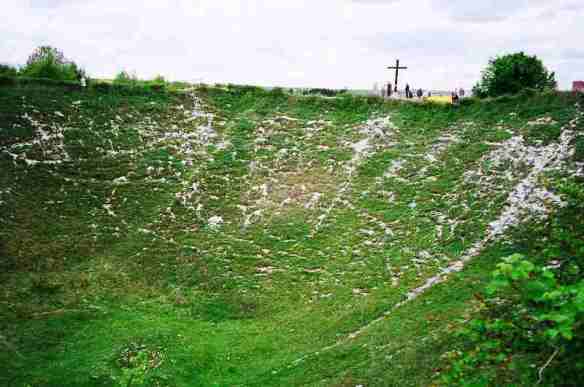“Hill 60,” by Nigel Cave, is one of the Battleground Europe books. Hill 60 — named because it was 60 meters above sea-level — is in the Ypres Salient, not far from Zillebeke. It was the scene of especially ferocious fighting during Second Ypres, in April 1915, where the British set off some of their earliest mines, and the Germans used some of their earliest gas. The Hill ended up in the hands of the Germans, who stayed until June 7, 1917, when the British set off the mines they had dug under the Messines ridge, including Hill 60.
Cave quotes an officer’s account of the explosion, which took place at about 3 o’clock in the morning: “First there was a double shock that shook the earth here 5,000 yards away” — he was at Zillebeke — “like a gigantic earthquake. I was nearly flung off my feet. Then an immense wall of fire that seemed to go half-way up to heaven. The whole country was lit up with a red light like in a photographic dark-room. … it makes one almost drunk with exhilaration.”
The explosion of the mines was said to be so loud, it was heard in London. Cave says 10,000 Germans were killed in the Battle of Messines.
Here’s another account of the big blast:
http://www.ww1westernfront.gov.au/zwarte-leen/1st-australian-tunnelling-company.html
Here’s a description of the memorials in the area:
http://www.greatwar.co.uk/ypres-salient/memorial-hill60.htm
I predict we will all take a much greater interest in mining on the Western Front when “Birdsong” comes to PBS in April.
Battleground Europe books are not for readers focused on the whys and wherefores. But they are unmatched if what you want is the who, what, when, where and how — unity by unit, even hour by hour.


I am not sure if it’s at Hill 60 but I once saw something on TV and some of those mine never exploded and are still buried in the ground, in their holes that are now filled with water.
One of those mines exploded a few years ago, when lighting struck a lamp pole and the electrical discharge ignited the mine underneath, in the ground. Fortunately no one was killed but many got the scare of their life
LikeLike
In 1955, a cow got struck by lightning, which plunged into the ground and set off a mine. Some surprise for the farmer, right?
I think there’s only one live one — well, I assume it’s live — left under the Messines ridge.
LikeLike
The photo of the mine crater is one I sent Susan and asked her to post. That is the Lochnagar Crater and it is one of the few photos I was able to take that could give a feeling for the scale of the thing (look at the people along the rim in the back).
Steve Suddaby, President, WW1HA
LikeLike
Hello just wanted to give you a quick heads up
and let you know a few of the pictures aren’t loading
properly. I’m not sure why but I think its a linking issue.
I’ve tried it in two different web browsers and both show the same results.
LikeLike
Thanks for passing this on.
LikeLike